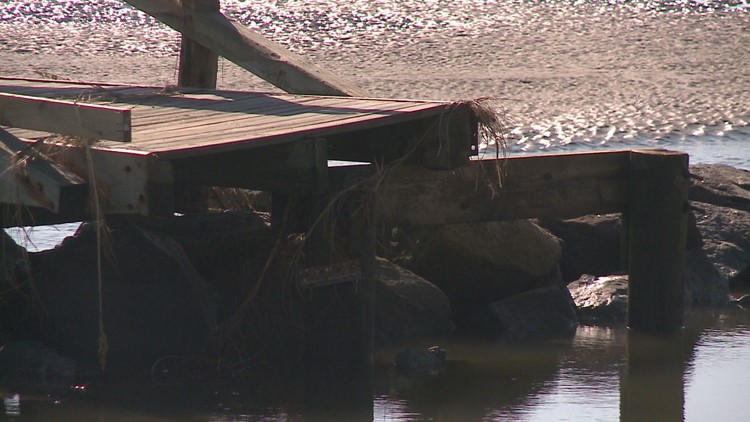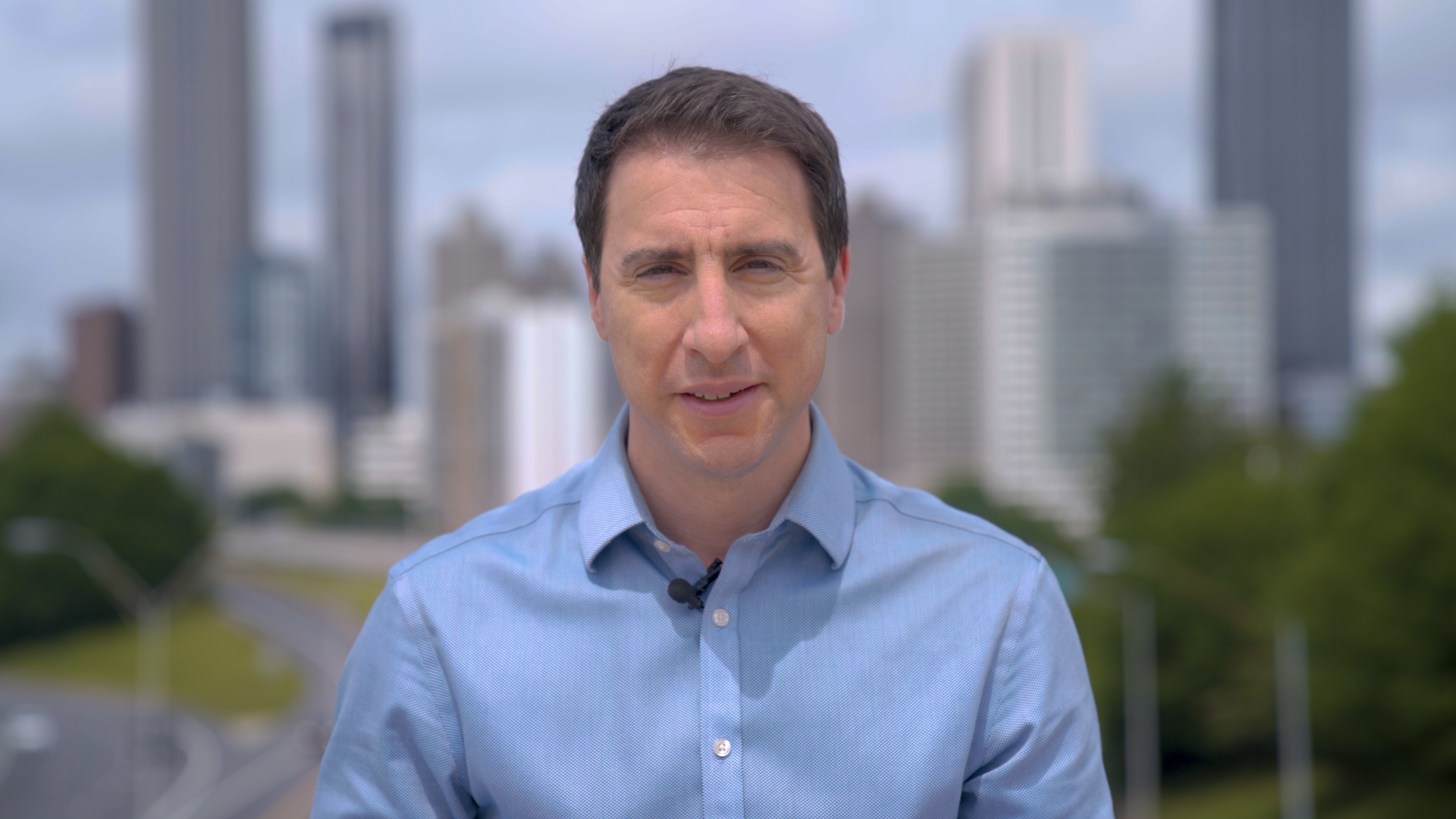The view from the coast shows Mother Nature at peace.


This view of the coast shows Mother Nature’s power.


Over the past few weeks, we’ve watched Mother Nature’s destructive children—Harvey, Irma and now Maria—bully some of the country’s biggest cities and beautiful islands. These are hurricanes with human names that we will all remember, like the name of that kid that picked on you in grade school. Similarly, recovery from the damage caused, whether it’s on a coastline or on a playground, can take years.
For residents in South Georgia, Irma’s bullying feels personal. That’s because it is.
“It’s disappointing”
“It’s disappointing,” says Duane Johnson pointing at a mangled dock. “They just repaired this not too long ago from the storm last fall.”
That storm was Hurricane Matthew. It menaced the southeastern coastline in October 2016 and many of Georgia’s coastal communities were affected by strong winds, rain and storm surge. Almost a year later, residents of St. Simons Island found themselves in recovery mode again. A one-two punch. Progress from Matthew meets setbacks from Irma.
“We’ve been lucky over the years. We haven’t had much of this,” Duane admits. “But between last fall and this on combined, the island’s taken a beating.”
Duane and his friend, Bobby Aylward, look over the scene. Comparatively, to their neighbors to the south, the men know they fared well. It’s true, thousands of Houstonians and Floridians have lost everything. But the damage to their community on St. Simons still hurts. The people here treasure the island’s beauty but understand its fragility.
“That’s the risk of living on the coast,” says Bobby.
Duane agrees. “That’s right. When it’s, nice it’s nice. When it’s not, you see the power of it.”
Irma's damages St. Simons Island
'It’s humanity'
That’s the simple explanation St. Simons business owner, Kathryn Ross, gives to describe the clean up effort in her community. “Neighbors helping neighbors” was the popular phrase used to describe Houston’s unity in the time since Harvey’s landfall. The same goes for the communities along Georgia’s coast post-Irma.
Kathryn is the co-owner of Pelican Market, a cool little shop on St. Simons Island. The market was spared from flood waters but was one of the million or so Georgia customers that lost power.
“We’ve lost a lot of inventory, all our ice cream,” Katheryn says. “Those freezers were a mess.”
Buildings may have been spared, but business will still take a hit. Small communities rely on small business.
Despite the hardship, Kathryn and the others at Pelican Market did what they could to keep the shelves stocked and spirits up.
“We just gotta keep plugging along like everyone else,” Kathryn says. “You just clean up, and you open up.”
The day the market reopened, customers were invited to come in and share their hurricane stories over coffee. It’s a moment of normalcy. A welcome break from the uncertainty.
“It’s humanity,” Katherine says as she welcomes customers into the store. “It’s humanity. It’s love.”
'Just laughing to keep from crying at this point'
The level of damage Irma left in its wake varies from block to block. And for many, the emotions come in waves.
“We had some friends down the road that had it worse than we did,” says longtime St. Simons resident, Amy Debreceni. She’s comparing the eight inches of flood waters that entered her home, to the three feet sustained by her friends.
Amy purchased her St. Simons Island home in 1999, and for the last few days, she’s worked to clear debris. She placed palm fronds and trash left behind after the water receded to the same garbage bag containing personal possessions that could not be saved. She says a dumpster won’t be available until next week. That’s valuable time lost, as the decay from water damage only worsens with each passing day.
“I took a picture of my flooded from yard. My brother photoshopped a giant rubber ducky over the front of it,” Amy says, managing a small smile. “Just laughing to keep from crying at this point.”


As Amy works to heal and repair after Irma’s beating, she has her eye on the next threat looming.
“Now we’ve got Maria starting to take the same path that Irma did. But if it does, I don’t have anything on my floors anymore, so it’s all good,” Amy says with a hint of sarcastic optimism.
It’s another attempt at laughing to keep from crying.
St. Marys
“You left, and everything was normal. You get back, and everything’s in chaos.”
In St. Marys, Georgia, you can track Irma’s destruction neighborhood by neighborhood just by looking at the sidewalks. Most homes in this coastal community avoided major flooding. In those drier areas, large piles of branches and leaves dot the side of the street. Utility workers armed with backhoes move the debris Irma left behind off the roadways. The drivers traveling down the now clear street is a sign of progress.
Unlike the utility workers, St. Marys resident, Sam Petrillo, isn’t armed with industrial equipment. Instead, his arms serve as both backhoe and excavator, as he adds to the growing number of debris piles on the side of the road.


“You left and everything was normal. You get back, and everything’s in chaos,” he says.
Sam’s house had minimal damage. He credits God for the protection of both property and person, especial his young son.
But when you travel toward the waterfront, the piles become more personal.
Beached boats and splintered wood from the docks are heaped along the water's edge. Some of the boats were for leisure, a reward for years of work and much deserved R&R for its owner. Many of those boats, however, served as a financial driver for the local economy. They were someone’s livelihood. The city expects damages well over a million dollars.
Hurricane Irma damages St. Marys
“It’s just an old fishing town that’s survived time,” says Stephen Sweat. “There’s a slim possibility of ever recovering the boats.”
Stephen doesn’t live in St. Marys, rather he chose to pay a visit after Irma hit.
“I saw some pictures on social media, but I wanted to come down and see it for myself,” he says taking it all in. The once familiar view of boats bobbing along the docks has been replaced with an unfamiliar stillness.
The repairs will take months, maybe years. But someone is working quietly to rebuild morale in St. Marys.
Near the piles of battered fiberglass and broken-down docks baking in the late summer heat stands, of all things, a snowman.


Three piles of white, craggy Styrofoam, once used for floatation under the concrete docks, are stacked 10 feet tall. The top piece is complete with two eyes, a nose, and an upturned, half-moon-shaped mouth. For some much-needed comic relief, Frosty’s cousin from down South is outfitted with a life vest.
The snowman appeared after the storm passed. Today, someone in St. Marys is laughing instead of crying, too.
Kingsland
In Kingsland, peoples lives are on their lawns.
“We’re dealing with losing everything, not having a house,” says Yolanda Ramsey. I don’t know what the next steps are.”
On two blocks in Kingsland, residents say nearly every home was flooded. Hardly any homeowners had flood insurance.
“My husband has seen stuff like this; he’s been deployed to Iraq twice,” Yolanda says. “This, to me, looks like a war zone.”
Hurricane Irma damages Kingsland, Georgia
Kingsland is a Navy community. Sacrifice and struggle are not unfamiliar, and rebuilding will not be a solo mission.
Travis Hammond works to clear the damage from his son’s flooded home on Honeysuckle Road. Travis’ son missed Irma’s onslaught and aftermath because he is currently deployed. Travis estimates the home sustained tens of thousands of dollars in damages. While Travis works hard for his son, Travis’ community is working hard for him.
“When we got here, there was 30-40 of ‘em waiting for us right when we got to the house,” Travis says. “The good thing about this right now is the community’s coming together.”
The residents of South Georgia’s coastal communities will always remember that bully-of-a-storm named Irma, and the way the winds and the rain beat up their neighborhoods.
But hopefully, they will also remember the neighbor that came to help when it was needed most; or when the strength of their community made the pain hurt less and the feeling of loss, less lonely; or when they found the strength to laugh to keep from crying.
If you want to help the residents of South Georgia, you can donate money at HelpSalvationArmy.org.































